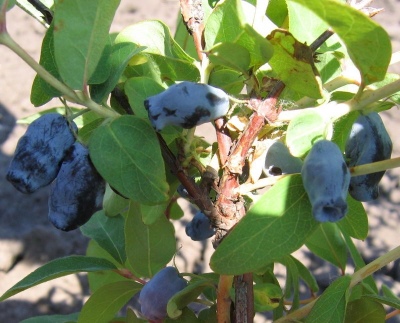
- Authors: L.P. Kuminov (Moscow region)
- Name synonyms: Princessa Diana
- Growth type: medium-sized
- Description of the bush: compact, medium-sized
- Bush height, m: 1,9
- Escapes: straight, gray-brown, no pubescence
- Leaves: elongated, bright green
- Crown: reverse conical, medium density
- Fruit size: large
- Fruit weight, g: 1,49
Unpretentious varieties of honeysuckle are chosen not only by beginners, but also by experienced gardeners who do not want to spend a lot of time caring for fruit crops. The honeysuckle berry is in great demand among Russian summer residents. It is not only tasty, but also healthy, and many delicacies and desserts can be prepared from universal fruits. The unpretentious varieties include the Princess Diana variety.
Description of the variety
The growth type of the above variety is medium-sized. The shrubs are compact and do not take up too much space on the land. The medium-dense crown allows the sun's rays to penetrate and warm the berries. Its shape is reverse conical. Plant height reaches 1.9 meters. Shoots without pubescence, color - gray-brown. They grow straight and even.
The shoots are covered with elongated foliage of bright green color. When the flowering period begins, the shrub is covered with a large number of white and large flowers. They grow in pairs, in the corners of the leaf plates. Many gardeners note the high decorative qualities of this variety.
Fruit characteristics
The weight of one berry is about 1.49 grams. One of the positive characteristics of Princess Diana honeysuckle is the large size of the fruit. Their shape can be either cylindrical or oval, oblong. The surface is uneven and covered with small tubercles. This appearance is considered standard for edible honeysuckle.
The color of the berries is dark blue, dense. The fruits are covered with a thin and delicate skin. Moderately juicy and dense pulp is formed inside.
Taste qualities
The dessert taste of the ripe fruit has played an important role in the growing popularity of the variety. The taste harmoniously combines sweetness and sourness. A faint and pleasant aroma is present. The bitterness is completely absent. The percentage of sugars - 9.3, dry matter - 14.7, organic acids - 3.4. And also the composition contains many useful trace elements.
Ripening and fruiting
Shrubs begin to bear fruit only for 2-3 years. Flowering occurs in the last spring month. Mid-season honeysuckle bears fruit from late July to early August.
Yield
On average, 2 to 4 kilograms of sweet berries are harvested from one adult shrub. Experienced summer residents are advised to pick the fruits a week after they ripen. So they will acquire the most vivid color and rich taste. It is advisable to work in dry and stable weather. The fruits ripen almost at the same time, so the entire crop can be harvested in one or two approaches.

Self-fertility and the need for pollinators
In order to harvest a rich, high-quality crop, pollinating plants should be planted next to the Princess Diana honeysuckle bushes. This crop is cross-pollinated. It is advisable to plant nearby from two fruit crops, which will help in the formation of the crop.
The following requirements are imposed on pollinators:
large berry sizes;
same flowering time with the main variety;
suitable height of shrubs (about two meters)
average duration of fruiting.
Growing and care
The first rule of successful fruiting is the choice of a suitable land plot. It should be at least 5 meters away from tall buildings and plants. The considered fruit crop prefers light and fertile soil, for example, loam and sandy loam. The earth should be well lit by the sun. It is advisable to plant shrubs in an area that is protected from wind and drafts. If they grow in comfortable conditions, they will please with a stable harvest.
It is very easy to grow an unpretentious berry. Many gardeners make a big mistake when they neglect even the simplest care rules. The cultivated varieties need regular attention. This is the best prevention of diseases and the basis for excellent yields. If you correctly follow the planting procedure, during the first two years the seedlings do not need fertilization and other agrotechnical measures. Regular watering will be sufficient.
In the third year of the life of shrubs, the following conditions should be observed.
Water the honeysuckle three times throughout the season. During dry periods, plants need an increased amount of moisture. The optimal flow rate is 10 liters of water per bush.
Fertilizers are applied once every two years, using mineral fertilizers and organic matter. Under one bush of honeysuckle Princess Diana, a urea-based solution is poured (50 grams of the product in a bucket of settled water). After 14 days, add 200 grams of ash and 10 grams of humus.
Mineral fertilizers are applied every year before flowering. A balanced complex designed specifically for fruit and berry crops is suitable.
Adult shrubs that are 12 years old are pruned for rejuvenation. During the procedure, only the root rosette is left, the rest is removed.
Sanitary pruning begins in the fifth year of the plant's life and is performed once every 2 years. The shrub is freed from dry, broken and old shoots.



































































